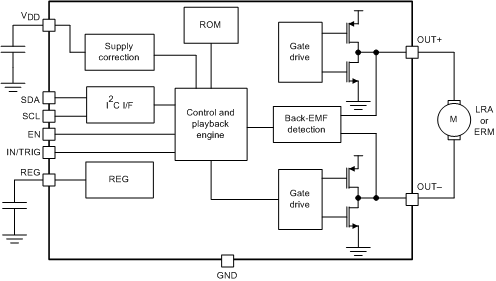ZHCSDF3D May 2014 – March 2018 DRV2605L
PRODUCTION DATA.
- 1 特性
- 2 应用
- 3 说明
- 4 修订历史记录
- 5 Pin Configuration and Functions
- 6 Specifications
- 7 Parameter Measurement Information
-
8 Detailed Description
- 8.1 Overview
- 8.2 Functional Block Diagram
- 8.3
Feature Description
- 8.3.1 Support for ERM and LRA Actuators
- 8.3.2 Smart-Loop Architecture
- 8.3.3 Open-Loop Operation for LRA
- 8.3.4 Open-Loop Operation for ERM
- 8.3.5 Flexible Front-End Interface
- 8.3.6 Edge Rate Control
- 8.3.7 Constant Vibration Strength
- 8.3.8 Battery Voltage Reporting
- 8.3.9 One-Time Programmable (OTP) Memory for Configuration
- 8.3.10 Low-Power Standby
- 8.3.11 I2C Watchdog Timer
- 8.3.12 Device Protection
- 8.4 Device Functional Modes
- 8.5
Programming
- 8.5.1 Auto-Resonance Engine Programming for the LRA
- 8.5.2 Automatic-Level Calibration Programming
- 8.5.3 I2C Interface
- 8.5.4 Programming for Open-Loop Operation
- 8.5.5 Programming for Closed-Loop Operation
- 8.5.6 Auto Calibration Procedure
- 8.5.7 Programming On-Chip OTP Memory
- 8.5.8 Waveform Playback Programming
- 8.6
Register Map
- 8.6.1 Status (Address: 0x00)
- 8.6.2 Mode (Address: 0x01)
- 8.6.3 Real-Time Playback Input (Address: 0x02)
- 8.6.4 Library Selection (Address: 0x03)
- 8.6.5 Waveform Sequencer (Address: 0x04 to 0x0B)
- 8.6.6 GO (Address: 0x0C)
- 8.6.7 Overdrive Time Offset (Address: 0x0D)
- 8.6.8 Sustain Time Offset, Positive (Address: 0x0E)
- 8.6.9 Sustain Time Offset, Negative (Address: 0x0F)
- 8.6.10 Brake Time Offset (Address: 0x10)
- 8.6.11 Audio-to-Vibe Control (Address: 0x11)
- 8.6.12 Audio-to-Vibe Minimum Input Level (Address: 0x12)
- 8.6.13 Audio-to-Vibe Maximum Input Level (Address: 0x13)
- 8.6.14 Audio-to-Vibe Minimum Output Drive (Address: 0x14)
- 8.6.15 Audio-to-Vibe Maximum Output Drive (Address: 0x15)
- 8.6.16 Rated Voltage (Address: 0x16)
- 8.6.17 Overdrive Clamp Voltage (Address: 0x17)
- 8.6.18 Auto-Calibration Compensation Result (Address: 0x18)
- 8.6.19 Auto-Calibration Back-EMF Result (Address: 0x19)
- 8.6.20 Feedback Control (Address: 0x1A)
- 8.6.21 Control1 (Address: 0x1B)
- 8.6.22 Control2 (Address: 0x1C)
- 8.6.23 Control3 (Address: 0x1D)
- 8.6.24 Control4 (Address: 0x1E)
- 8.6.25 Control5 (Address: 0x1F)
- 8.6.26 LRA Open Loop Period (Address: 0x20)
- 8.6.27 V(BAT) Voltage Monitor (Address: 0x21)
- 8.6.28 LRA Resonance Period (Address: 0x22)
- 9 Application and Implementation
- 10Power Supply Recommendations
- 11Layout
- 12器件和文档支持
- 13机械、封装和可订购信息
3 说明
DRV2605L 器件是一款低压触觉驱动器,其包含触觉效果库和闭环致动器控制系统,可为 ERM 和 LRA 提供高质量的触觉反馈。此方案有助于提升致动器在加速度稳定性、启动时间和制动时间方面的性能,通过共用的 I2C 兼容总线或 PWM 输入信号即可触发该方案。
DRV2605L 器件提供了 Immersion 公司的许可版 TouchSense 2200 软件,其中包含 100 多种许可版效果(6 个 ERM 库和 1 个 LRA 库)和 audio-to-vibe 功能,因此无需设计触觉波形。 功能。
此外,主机处理器可利用实时回放模式绕过库回放引擎并通过 I2C 从主机直接播放波形。
DRV2605L 器件内部采用智能环路架构,可轻松实现自动谐振 LRA 驱动,以及优化反馈的 ERM 驱动,从而提供自动过驱动和制动。这种智能环路架构可构建简化的输入波形接口,并且能够提供可靠的电机控制和稳定的电机性能。此外,DRV2605L 器件还 能够 在 LRA 致动器不产生有效反电动势电压时自动切换至开环系统。当 LRA 产生有效反电动势电压时,DRV2605L 器件会自动与 LRA 同步。 DRV2605L 还可以利用内部生成的 PWM 信号实现开环驱动。 此外,“audio-to-vibe”模式可自动将音频输入信号转换为实际的触控效果。
有关 Immersion 软件的重要说明,请参阅 法律声明 部分。
器件信息(1)
| 器件型号 | 封装 | 封装尺寸(最大值) |
|---|---|---|
| DRV2605L | DSBGA (9) | 1.50mm x 1.50mm |
| DRV2605L | VSSOP (10) | 3.00mm × 3.00mm |
- 如需了解所有可用封装,请参阅数据表末尾的可订购产品附录。
简化原理图
